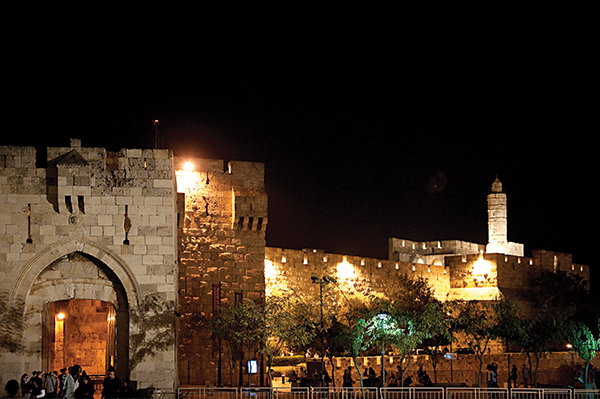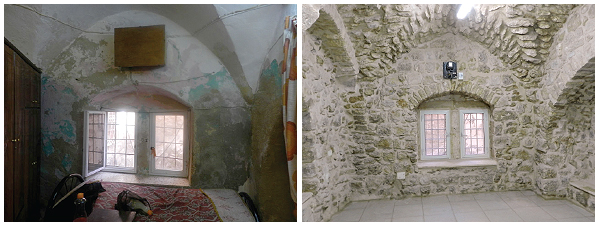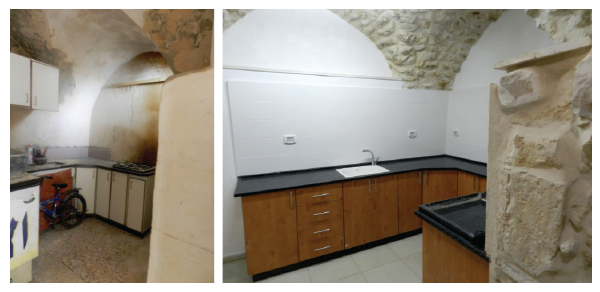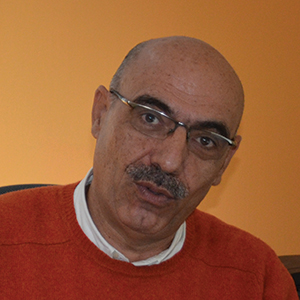
In 1996 the Israeli government introduced a law that prohibited Jerusalem residents from living outside the municipal borders, or within Israeli sovereign territories in general. Many Jerusalemites were already living in Bethlehem, Ramallah, Al-Ram, and other places in the West Bank. Some of these families had left Jerusalem, their center of life, to find a cheaper cost of living elsewhere, closer to their work, and to find affordable housing. Among the families who left in the 1980s are families who lived in the Old City. Under the threat of losing their residency privilege, a large number of families started to move back to their old homes. Lack of housing, difficulty in obtaining building permits in Jerusalem, and the high cost of land and building encouraged people to revert to living in the Old City, especially those who had lived there before and those who still owned shares in houses in the sacred city.
A number of the houses in the Old City had been unused for a long time, some even abandoned. These old structures that are made of stone and lime are very susceptible to damage due to high humidity and lack of aeration when not inhabited. Renovation and rehabilitation were urgently needed.
Various organizations that work in Jerusalem took the initiative to fundraise for and administrate such works since the unfortunate families who owned these properties were unable to cover the renovation costs themselves. The idea was very successful. More NGOs moved in to help in this mission and fundraising became easier.
During the first years, the results were poor. The work, the needs, the approach, and the difficulties were changing all the time. Neither the administrative teams nor the engineers or contractors had adequate experience in this field, and the specialized materials to be used were unknown to the engineers. In addition, the renovations needed to be completed in a very short time, which contributed to the poor quality of work.
With time, however, things changed for the better. New engineers and architects joined the works; major institutions hired experienced personnel, others organized seminars to share know-how and expertise. Today the renovation works can be described as good, with more experienced team players who are better prepared and more competent in restoration and conservation methods and techniques.
♦ Renovation work in the Old City of Jerusalem is a very complex process that includes not only the engineering aspect but also the relationship with local authorities and the need to protect the heritage value of the structures. Given this complexity, very few architects and contractors choose to get involved in this work.
The municipality of Jerusalem and the Israel Antiquities Authority also significantly affected the work. The municipality does not usually facilitate the construction of new buildings or even additions to the properties of the Arabic population in the Old City. Fewer than ten permits were granted during almost 50 years of occupation. To make things more difficult, the Antiquities department closely monitors any construction in the city, under the pretext of preserving the antiquities and heritage of the city.

Both the Antiquities Authority and the municipality share interests and motives; they were able to slow the construction activities in the Old City, increasing burdens – specifically financial burdens – on the interested parties. The Antiquities Authority requires a $300-per-day observation fee for personnel. Unlucky sites may need 10, 20, or even more days of observation. In one case, the beneficiary had to pay approximately $10,000 in observation fees to the Antiquities Authority.
At first, the authorities were satisfied with visits to the construction sites to make sure that no building additions were being constructed. If additions were discovered, then the works were halted by court order and the owners required to pay a heavy penalty. Demolitions were carried out in some cases. In later stages the authorities started to ask for detailed work plans and descriptions. This made it more difficult for beneficiaries to carry out the work they had planned.
During the last decade, building additions almost completely ceased as it became too dangerous and too expensive to continue. Some architects working in this field discovered that an alternative to building an addition was either to upgrade the available space and make it more useful or to look for unused spaces and render them available and useful.

During our work in the oldest quarters of the city, such as Haret Alsadieh, Bab al-Silsileh, and Bab Hutta, we were stunned by houses used in shifts: some families would use the bedrooms in the daytime and others at night, and together they would share living rooms and kitchens and toilets. In such cases, before starting the rehabilitation process, we and the beneficiaries had to find alternative rooms to use, and in other cases, we had to do the work in stages to keep a minimum amount of space where the inhabitants could sleep. It is worth mentioning that these parts of the Old City are among the most population-congested areas in the world.
As mentioned before, we had to look for new spaces to enlarge the living capacity of the city: caves became useful, old stables became bedrooms, rooms with high ceilings were bisected by a mezzanine floor, hallways were also converted to family space.
During the rehabilitation of the new areas to be used, we had to install new services, such as sewage and ventilation, for which some excavations had to be done. This posed a significant problem for the Antiquities Authority, which imposed heavy supervision on the project. This has significantly slowed the work and increased costs due to the fees required by the authority. Given that most of the NGOs working in the city refuse to pay taxes or fees to any Israeli authority, the burden of payment is laid on the beneficiary, who is already financially exhausted.
All parties working in this field – including donors, administrators, architects, and contractors – have learned a lot through this process. During the last twenty years, they have upgraded the quality of their work and at the same time have learned how to maneuver through the obstacles put in place by the authorities.
Seminars run by local NGOs teach architects, engineers, and contractors how to deal with old structures, keep our heritage alive, and make the best use of a space without causing damage. New, more effective construction materials have been introduced to architects and contractors. In the old alleys of the city, one again hears familiar words such as lime, argil, and hydraulic cement, among others.
We are proud to share that the quality of our renovation and rehabilitation works has been improved, and that our zeal for traditional building materials and our grandfathers’ stones has been restored. We strive for the highest professional level in conservative restoration of the structures in our city.
If Jerusalem were a free, sovereign city, it would be possible to create a new model for the city with wise building additions that would preserve the authenticity of this holy place and meet some of its growing needs. For now, however, a local conservation committee can be charged with overseeing the work and encouraging all to:
KEEP OUR HERITAGE ALIVE!
» Simon Kouba is an architect and the owner of Simon Kouba Consultants. He is a member of several boards that work with youth, arts, and culture. He can be reached at simon@koubas.net.


